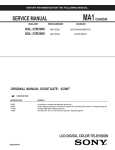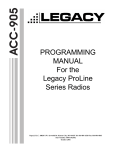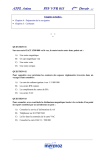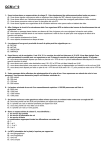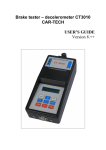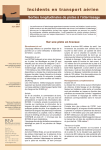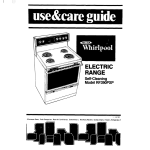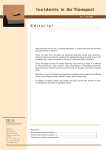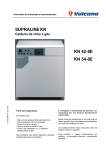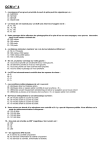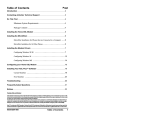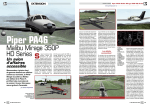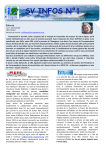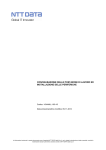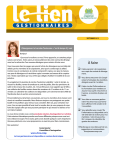Download ITA n° 7
Transcript
Incidents in Air Transport Operations in Winter Conditions N° 7 October 2007 The presence of snow on a runway during takeoff and landing, the need for de-icing aeroplane before departure, are conditions that are infrequently encountered on French airports. To maintain a level of safety equivalent to that obtained outside of these conditions, all those involved must be willing to act as if these exceptional circumstances were part of the routine. Crew actions are obviously crucial, as is the quality of ground assistance. The following examples highlight certain characteristics of these operations. Lateral excursion on slippery runway This was the first aeroplane to land after the reopening of the runway. (1) (2) The landing weight was 16.5 t. Bureau d’Enquêtes et d’Analyses pour la sécurité de l’aviation civile Zone Sud Bâtiment 153 200 rue de Paris Aéroport du Bourget 93352 Le Bourget Cedex FRANCE Tél. : +33 1 49 92 72 00 Fax : +33 1 49 92 72 03 [email protected] History of Flight An Embraer 145 took off from Lyon for Basel Mulhouse at night after a delay due to cleaning snow from the aeroplane. Twenty minutes after takeoff, the crew was informed of a one-hour closure of the destination aerodrome due to snow clearance operations. When the airport was reopened, the crew checked the landing distance available (LDA). With transmitted friction coefficients of 0.16, 0.14 and 0.14 (1), the onboard documentation provided landing performance consistent with the weight of the aeroplane (2) . The stabilized approach was performed with flaps 45 ° configuration at a speed of 130 kt and touchdown was normal. During deceleration, the plane swerved slightly to the left. The Captain, PF, corrected by first using the brakes and then thrust reversers asymmetrically. The aeroplane lurched to the right, which the PF could not control by pushing left. The aeroplane left the runway and rolled along the grass for a distance of 250 metres. It returned to the runway through an input on the nosewheel steering control. The plane reached its parking position autonomously without suffering damage. The excursion caused no damage on the ground. Additional Information Destination weather Conditions observed two hours before departure: 5,000 metres visibility, rain, temperature 0 ° C. Conditions at the time of departure: wind 300 ° / 10 kt, visibility 1,500 metres, mist, rain, temperature 0 ° C and dew point -1 ° C. The weather dossier made available to the crew did not contain a SNOWTAM. Two SNOWTAM were issued after the departure of the aeroplane. The first reported a depth of 5 mm of wet snow and snow clearance in progress. The second, issued at the time of the reopening of the runway, announced wet snow and ice to a depth of 5 mm, the braking coefficient and snowfall causing wet snow to freeze on the cold runway. Analysis of the excursion Analysis of the flight parameters showed that there were no gusts of crosswind, that the thrust reversers extended simultaneously and that reverse thrust was not immediately applied. The excursion seemed mainly due to the surface being made very slippery by the presence of wet snow. The faster acceleration of the right engine at the time of application of reverse thrust could have triggered the initial deviation of the aeroplane. Locking the steering to the left at the time of the lurch to the right contributed to the nose-wheels deviating. The crew tried to counter the skid using asymmetric reverse thrust. This technique, which is not described in the operating manual, did not prevent the excursion. Evaluations of performance on slippery runways An aeroplane’s tyres’ adherence to the runway is essential for the rotation of the wheels on landing, braking and steering control. Adhesion can be quantified or assessed by one of three methods: • a description of the runway surface (type and depth of possible contaminant), based on observations by aviation personnel on the ground; • the friction coefficient of the runway (runway-μ) measured by a system mounted on a ground vehicle. This measurement determines the maximum braking slip and corresponds to the slip point of the tyre; • braking efficiency, evaluated by the pilot at the time of landing and described as good, fair or poor. Only the last evaluation takes into account certain aeroplane p a r a m e t e r s . However, this information is not available the first plane landing. 2 Freinage avion et coefficient de freinage Résumé des méthodes Freinage avion calculé Freinage rapporté Données du constructeur 0. 4 Coefficient de freinage de l’avion (calculé) µ avion Sèche 0. 3 0. 2 0. 1 Bon Moyen Médiocre 0. 0 Description de la piste 1. 0 Meilleur freinage Sèche Coefficient 0. 8 Mouillée Neige sèche de friction de la piste 0. 6 Neige compacte (mesuré) Neige mouillée Slush Glace Glace mouillée Source Boeing Mesure du coefficient de freinage µ piste OACI Bon 0. 4 Moyen 0. 2 Médiocre 0. 0 Plus mauvais freinage Measuring the friction coefficient is carried out when necessary on each third of the runway. In this case, it is expressed digitally or as a quantity. The following table shows the corresponding ICAO coefficient as defined for defining a SNOWTAM: Coefficient (3) The depth can be difficult to measure, especially when water is present. (4) WED : Water Equivalent Depth. (5) Only two types of contaminants are available, «Packed snow» and «Wet ice» with two columns for the latter type depending on whether the friction coefficient is greater (*) or lower (**) 0.25. incidents in Air Transport Terme utilisé 0,40 et plus Bon Good Entre 0,39 et 0,36 Moyen/Bon Medium Good Entre 0,35 et 0,30 Moyen Medium Entre 0,29 et 0,26 Moyen/ médiocre Medium Poor 0,25 et en dessous Médiocre Poor 0,09 et en dessous Douteux Unreliable In addition, manufacturers have different methods for characterizing the braking of their aeroplane. For Boeing, the calculation of landing performance uses a braking coefficient (plane-μ which can not be directly compared to the runway-μ) based on description of braking efficiency (good / average / poor). The difference between the runway-μ and plane-μ reflects the limits of the efficiency of the braking system. Airbus bases its calculations on the type and depth of the contaminant (3) . For Embraer, the presentation of performance is described below. Documentation available on board The flight manual contains tables that offer two ways to calculate limitations on a contaminated runway. The first is based on an equivalent water depth (4) and provides limitations based on aeroplane landing To obtain WED, multiply theContaminant Depth by the Contaminant Specific Gravity. weight and the runway distance available The second determines the runway distance required depending on the weight of the aeroplane and the contamination of the runway (5). Lessons Learned Difficulties on a contaminated runway are not limited to braking capacity in relation to the runway distance available. This event shows others related to lateral control. The use of asymmetric thrust reversers, a non-specified procedure, without a doubt contributed to the excursion. Manufacturer’s data only deal with landing performance. In this respect, crews are faced with the difficulty of interpreting the parameters describing the contamination and their correlation with data provided by the manufacturer. The different methods used to describe the condition of a runway use different scales. As it is not always possible to establish an exact correlation between the parameter that describes the runway (or friction coefficient of condition of the runway) and the braking capabilities of the aeroplane and as there is no correlation rule accepted as a standard in the industry, it is up to operators to provide their aircrew with a method to easily determine landing conditions based on information transmitted on the condition of the runway. Following this incident, the airline, for example, amended its operations manual to add the following instruction: « It is forbidden to take off and/or land with a measured friction coefficient lower or equal to 0.25 » Takeoff after incomplete tailplane de-icing History of Flight An ATR 42 was making its first flight of the day on a morning in March. Temperature was close to 0 ° C and the dewpoint temperature was - 1 ° C. Half an hour before the scheduled departure time, moderate snow fell for about ten minutes(6) and the crew decided to de-ice the aeroplane. Passengers were boarded. The operation was performed by a support company ramp agent in about fifteenminutes(7) while the crew in the cockpit, kept the control column hard forward in accordance with the de-icing procedure. The equipment used was a cherry picker with a tank filled with a heated mixture of fluid type II and water. The truck was positioned at the side of the plane between the trailing edge of the wing and the tail. The ground operations coordinator, in contact with the ramp agent by walkie-talkie, relayed the end of the operation to the crew from the line station. The copilot noticed that the leading edges of the wings were still contaminated. He told the coordinator who came himself to carry out the additional deicing, but only on the wings. After the end of de-icing and before starting up, the crew did not perform the specific procedure to test the deflection of the flight controls. At the holding point, during the usual flight control tests the copilot, PF, found that the elevator control was quite hard to manoeuvre. He pointed this out to the Captain, who did not feel the phenomenon. It was then concluded that residues from de-icing were the cause and that they would disappear with the relative wind during the takeoff run. Soon after the rotation, the aeroplane pitched up significantly. The crew had to pitch down in order to compensate in order to control it. The maximum deflection of the trim was reached and the crew still had to push the elevator control. After several attempts, they stabilized the aeroplane at FL 70 at 180 kt and diverted to the alternate airport. The aeroplane’s behaviour improved slightly. It landed without any further problems. Additional Information Aerodynamic explanation of the phenomenon The hinge moment of the elevator can be affected by the presence of residual ice or other contaminants on the tail. The boundary layer at the rear of the profile is modified. This can cause the elevator to pitch up. To restore balance the aeroplane must be pitched down. If contamination is significant, the nose-down stop can be reached without the hinge moment of the elevator being cancelled and additional inputs to pitch down the aeroplane must be made to reduce the aeroplane’s attitude. 3 (6) This was the only rainfall before aeroplane departure. (7) This was the first time that the agent had done this. De-icing procedures An operator must define procedures to be followed for de-icing or anti-icing on the ground, and for checks on the condition of the aeroplane after these operations. For this purpose, instructions must be included in the Operations Manual. The procedures below are from separate parts of the operator’s manual. - avril 2005 n°n° 7 -3October 2007 In the General section are: (8) This phenomenon cannot explain the sensation of effort on the elevator control during testing of this surface. Responsibilities The decision to perform de-icing and/ or anti-icing is the responsibility of the Captain. (…) the assistance provider icing and / or icing (Airline ramp assistants, assistance company, CCI, others ...) is responsible for: - The correct execution of the treatment and the result obtained, - Training support staff [...] Visual and touch inspection checks on both wings must be performed by the mechanic or by the Captain in the absence of a mechanic, in particular after application of a treatment and before engine start-up [...] Checks Checks on the de-icing / ant-icing product used is the responsibility of the person undertaking the work (self-check) [...] At the end of operations, a visual inspection and touch check is performed by the mechanic or by the Captain. This check determines whether the treatment was effective and if all critical aeroplane areas are free of ice or snow before push-back or taxiing [...] After de-icing / anti-icing the crew ensures the correct movement of all control surfaces and repeats this check before the aeroplane enters the runway [...] 4 In the “Usage” part of the Operations Manual, there are other instructions concerning deicing: (9) These operations are unusual, a simplified guide may be useful to crews. To ensure the best icing / anti-icing possible for the horizontal stabilizer, during any application of fluid, the control column should be held firmly forward at the stop [...] After de-icing / anti-icing procedure, levels of effort on the elevator that are greater than normal may be encountered. These levels of effort can be more than twice those normally encountered. This should not be interpreted as a blocking of the elevator leading to an unnecessary decision to abort takeoff after V1. Although not systematic, this phenomenon must be expected and called out again during the pre-takeoff briefing each time a de-icing / anti-icing procedure has been applied. This increase in efforts on the elevator is strictly limited to the rotation phase (8) and disappears after takeoff. Assistance providers Each provider is responsible for staff training. An annual audit is performed by the quality assurance manager of the airline that uses this service. In the case under consideration, the agents that might perform de-icing / antiicing procedures received training, at the end of which they were overall given authorisation for initiation, implementation and checking these operations. The training, which lasted for a day, was purely theoretical. No practical training was planned. Lessons Learned Some uncertainties remain about procedures used for de-icing. The ramp agent conducted the operation for the first time without having received training. That was why it was not easy for him to see that the operation had not been correctly completed. Since that time, the assistance company has set up practical training for its agents. The visual and touch check after de-icing planned by the operator was not performed. On the one hand, the mechanic was not present. On the other hand, if this check should have been performed by a pilot, he must put on a harness to climb into the cherry picker and this is impractical during departure. It was found that the procedures to ensure checks are not appropriate in all situations that may be encountered at a stopover. In addition, the procedures for de-icing / anti-icing on the ground are in two different manuals (9), which may explain why a part of the procedure was not applied, specifically the checks on the controls after the de-icing. Accumulation of melted snow on landing gear on takeoff Histoy of Flight Un Fokker 70 décolle de Lille de nuit, aux A Fokker 70 took off from Lille at night, at around 18 h 00, in the snow. A runway inspection that had been conducted shortly before had determined that braking was good and this information was passed to the crew. Incidents in Air Transport They found it difficult to control during thrust application and asked the tower, after takeoff, when the runway would be treated. During the approach to the destination airport, while the aeroplane was at 2,000 feet, the crew ordered landing gear extension. The LG MAIN UNSAFE display appeared and the lights indicating nose and left main LG lock down did not illuminate. The Captain decided to abort the approach. The aeroplane was vectored to holding to allow the problem to be handled. The crew made several landing gear extension commands, normal and emergency, without success. The Captain, after informing the controller decided to make a few high bank-angle turns to try to lock down the landing gear by gravity. These attempts were unsuccessful. Shortly afterwards, the nose gear locked down locked. The crew applied the «landing with abnormal landing gear configuration» procedure and declared an emergency. The controller requested a delay in order to put in place the emergency services. Meanwhile, the Captain asked the cabin crew to prepare the cabin. The aeroplane was vectored to final approach and cleared for landing. Descending through 1,200 ft, the left gear lockdown light came on and the transition light turned off. The plane landed and was towed to the ramp. Additional Information Cause of the non-locking gear The axis of the left main landing gear lock hydraulic actuator was found broken. This was due to an overload compression failure. Immediately after landing, a significant amount of ice was found around the different parts up the landing gear. Broken part of actuator Failure profile Communications on the meteorological situation We a t h e r i n f o r m a t i o n a t L i l l e L e s q u i n indicated: between 14 h 40 and 15 h 05, rain and sleet; between 15 h 05 and 15 h 27, continuous rain; between 15 h 27 and 16 h 26 intermittent rain; between 16 h 26 and 17 h 36 rain and sleet; between 17 h 36 and 19 h 30, snow. The content of the ATIS was as follows: «Information Oscar recorded 17 h 24 active runway 26, runway wet, wind 250 ° / 7 knots, visibility 7 km, overcast, FEW 2000 ft BKN 000ft 5, temperature 0 ° C, dew point -1 ° C «. The following ATIS recorded at takeoff, stated: «Information Quebec recorded at 17 h 59 active runway 26, runway wet, wind 270 ° / 8 kt, visibility 4 km, moderate snow showers, FEW 300 ft, 5000 ft BKN, temperature 0 ° C, dew point - 1 ° C. ‘ Operations at Lille During the previous rotation, after landing at Lille at 16 h 35, the Fokker 70 crew reported to the controller, at his request, that snow was beginning to stick on the runway. At 16 h 38, the Tower chief contacted the meteorological service to know whether the snow would last. The latter believed that the snow would melt and stopp within one hour. At 16 h 57, the snowfall was increasing, the agent’s office called the Tower chief to know whether a friction coefficient measurement was required. The aeroplane that had landed previously reported that braking was good. At 17 h 00, a plane landed. The crew reported that snow hindered visibility severely on short final though they were told that the snow was light. Braking was still good. At 17 h 08, the agent’s office again asked for the runway friction coefficient measurement. The Tower chief, who noticed that the snow was beginning to settle on parking area, requested an inspection of the runway. At 17 h 14, an aeroplane ready for departure declined the proposal made by ATC for a runway friction coefficient measurement to be made before takeoff. At 17 h 23, the runway friction coefficient measurement was completed. The braking coefficient was 0.56. The information transmitted to the various crews that requested it was that «braking is good.» No mention was made of the presence of melting snow. At 17 h 32, the Tower chief again contacted the meteorological services to know how long the snowfall would last. They told him that it might last several hours and a thickness of 3 to 6 cm snow soil was announced. At 17 h 34, the LOCALIZER broke down. Snow on the antenna was doubtless the cause. The ceiling was 300 ft and this made it impossible for any more planes to land in these conditions. At 17 h 46, the Fokker 70 asked for pushback. At 18 h 06, the ramp services contacted the Tower for the result of the last runway inspection. The agent that responded did not conduct the inspection himself but he stated that a film of a centimetre of «slush» was observed. A runway treatment was referred to but this was delayed due to continuing snowfall. 5 Inspections of runways and SNOWTAM Contrary to the runway inspection at 17 h 23, that at 19 h 40 mentioned the presence of slush and a braking coefficient of 0.52. A SNOWTAM was published at 20 h 00 indicating wet snow over the entire runway. n° 7 - October 2007 Other aeroplanes affected Another airplane of the same type, having departed shortly afterwards, met with the same difficulties when trying to extend the landing gear. Melting snow accumulated on the landing gear during the takeoff run and acceleration had frozen during the climb and cruise. At the time the gear was extended, the nose gear lockdown indicator light remained off. The crew applied the associated procedure and managed to lock down the landing gear. On the ground, no failure was found in the system. It appears that the incident was due to a landing gear sensor being blocked by ice. Organization of runway inspections In France, the organization of runway inspections can depend on various agencies (State or management). The 15 March 2002 decree defines the conditions under which manual inspections must be performed... » 6 Inspections of the movement area of the aerodrome consist, among other things, of: - Collecting information on the overall condition of the area; - Undertaking, as necessary, immediate corrective actions - Reporting to the authority in charge of air traffic services, to air traffic control and / or the management. [...] Checks in the context of inspections shall include the presence of snow, snow drifts, ice, melting ice. When the aerodrome receives at least one scheduled commercial airline, at least two daily inspections are to be performed. Additional inspections may be required depending on the circumstances, including special weather phenomena: snow, ice... » A report is to be made by radio to air traffic services and actions and observations of the inspection team recorded. Training of agents who are responsible for inspections is the responsibility of the agency responsible for administering the aerodrome. Lessons learned The report made after an inspection on a snowy runway can take many forms: transmission of a runway friction coefficient, d e s c r i b i n g t h e s t a t e o f t h e r u n w a y, transmitting a SNOWTAM. In this case, the agent who measured the friction obtained a gross value of 0.56, which he converted to «braking good ». From this result, it was not considered useful to report the presence of slush. If the knowledge of the braking coefficient is in fact an essential element, specifically for takeoff performance purposes, the runway inspection should not limit itself to supplying this parameter. The manual on inspections makes it clear that all information concerning the presence of snow or slush must be provided. The study of this event by the airport quality assurance team made effective feedback possible. The impact of contamination on the ground on aeroplane systems is often underestimated compared to performance. In addition, the radio and telephone communications used during this investigation brought to light differences of opinion on the rapidly changing meteorological conditions between the various people involved. Finally, the manufacturer recommended slightly delaying retraction of the landing gear after takeoff from a contaminated runway to remove any snow or ice, which the crew did not think of doing, probably because they were surprised by the condition of the runway on takeoff. Overrun on a snowy runway (10) The PF said after the event that the first one hundred and fifty metres deceleration was correct, then the runway became very slippery and braking practically impossible Incidents in Air Transport History of Flight A Learjet 35 took off in the early evening from Vienna (Austria) to Chambery, which the crew estimated they would reach in two hours. The Captain was PF. Lyon SaintExupéry was diversion aerodrome. Meteorological information was collected by the crew at Vienna, then information received in flight made it possible to land at Chambéry. The crew, under radar vectoring, intercepted ILS 18 and continued the approach. The controller cleared them for landing and transmitted «runway wet and braking action good «. The aeroplane landed at the reference speed of 127 knots. The aeroplane touched down at the markings. It began to decelerate, then skidded (10). The PF succeeded in keeping to the runway centreline. The controller saw the plane at a speed that he estimated to be too high to allow the aeroplane to exit the runway before the south taxiway. He then asked the crew to make a U-turn at the end of the runway and backtrack to reach the parking area. Braking became effective again at the turn-around area, but the aeroplane overran the runway end by a distance of about fifteen metres. The crew announced a runway excursion. The controller, who did not see it, due to the dark, triggered the alert. Additional Information Characteristics of the runway The aerodrome, located at an altitude of 779 ft, has a runway 18/36 that is 2,020 metres long. The Runway 18 LDA was 1,790 metres. The slope of the ILS approach was 4.46 degrees (7.8%). Meteorology The crew had a flight dossier that forecast rain on arrival, with a possibility of snow (11). During the approach they received the following parameters: «runway in use 18, wind is calm, instrumental visibility is 2 km, snow, mist, FEW 500 ft, BKN 1300 ft, 1800 ft OVC, temperature +0 ° C / -1 ° C, QNH 997, QFE 969, transition level 70, runway is wet. « They thus expected a landing on a wet runway. An aerodrome warning message (12) issued at the end of the afternoon reported snowfall: « LFLB AD WRNG VALID 231700/242300 (HVY) SN (5 cm). Snowfall gradually is reducing during the day, it will affect the airport in the late afternoon and will continue during the night and tomorrow in the form of snow showers. Although low, the expected snow depth may hinder aerodrome activity. »The controller seeing that the grass area around the runway was beginning to whiten, the runway remaining black, asked, twenty minutes before the Learjet’s landing, for a grip measurement to be made. After the measurement, it continued to snow. Aeroplane performance The performance calculation was made at the time of flight preparation with software and did not indicate any limitations. Conditions being consistent with those were anticipated during the preparation, the crew did not make any in-flight calculations. The calculation made using the flight manual graphs gives, at a landing weight of 13,900 lbs, a landing distance of 850 m on a dry runway. This corresponded to a runway length required of 1,420 m on a dry runway and 1,630 m on a wet runway. On a runway contaminated by ice, under the conditions on the day, the maximum landing weight was 10,000 lbs. It is notable, however, that the AFM only provides performance figures for a «dry» or «frozen» runway, without any means of calculation for intermediate conditions. Braking conditions on a runway. There are several devices for measuring braking coefficient on a snowy runway. The most important aerodromes or those most at risk are provided with equipment to measure the coefficient on almost all of the runway. Equipment that is lighter, for making spot measurements, of the accelerometer type, are available at most other aerodromes. Finally, there is a « subjective » method for assessing the quality of grip by means of suddenly braking vehicle. This practice is not recommended by the authorities. The AIP France, in the « snow plan » section, provides the following information: Tapley type decelerometers are currently available to perform measurements relating to braking conditions: these devices are mounted on commercial vehicles with a weight of the order 1 000 kg. The measurements are performed using Tapley decelerometers only in the « Test » position and making braking tests at a speed of 40 km / h, with sharp locking of the wheels until the start of a slide. The braking tests are carried out at distances ranging from 200 m and 400 m along lateral lines located about 10 m on either side of of the runway centre line and other locations considered more representative of the condition of a section of a determined runway. The measurement result is expressed as a coefficient... » Measuring Equipment The equipment used to Chambery was an electronic decelerometer, manufactured in Canada, whose operating principle was identical to the above description. It was in use at many French aerodromes. It had to be installed on a vehicle not equipped with ABS brakes or hydraulic shock absorbers (13). After having compensated the device on the vehicle, the driver had to drive at a speed less than 40 km / h and stop suddenly to block the wheels. The equipment records the actual deceleration value which is converted automatically to a friction coefficient. This coefficient is called CRFI (Canadian Runway Friction Index) which is different from friction the ICAO friction coefficient. Its meaning is given below. The correspondence between the value of the friction coefficient and the quality of braking is not provided in the equipment operating instructions, that users refer to. The firefighters deploy this equipment (14) at Chambery. Measurements are recorded or printed out and sent to ATC services. Braking conditions are transmitted to the crews as « good » if the coefficient is greater than 0.40 or directly using the value of the coefficient. On the day of the event, the friction coefficient measurement was made at five points along the runway. At the displaced runway 18 threshold, one at the markings, another at the level of the central taxiway, a fourth at displaced threshold 36 and a last one a little before the central taxiway coming back from the threshold of 36. 231524 LFLB 231400Z 36012KT 6000 RA BKN017 PROB30 TEMPO 1824 4000 SN SCT003 BKN010 = (11) (12) The MAA are for airport operators and ATC organisations in order that they can take necessary steps when specific phenomena are expected. (13) These indications are not mentioned in the equipment user’s manual The equipment had only been received by the users two months previously. They had then performed some tests. This was only the second runway friction test performed. Use of the decelerometer was undertaken using the instruction sheet provided. (14) n° 7 - October 2007 7 Correspondance entre les coefficients CRFI et OACI 1. 0 Bon CRFI μ piste 1. 0 0. 53 0. 37 0. 8 OACI μ Moyen piste Bon 0. 6 0. 4 Moyen Médiocre 0. 2 0. 17 Nul 8 0. 0 Médiocre Douteux The measurements were made as follows: at a speed of 60 km / h, the driver braked suddenly, without going as far as locking the wheels although he noted the presence of slush on the runway. Three values were communicated to the controller: 0.44 at threshold 18, 0.51 at mid-point and 0.55 at threshold 36. The result being superior to 0.40, the braking was passed as «good» on the ICAO scale available to the tower, though it should be classified as «average» according to the CRFI scale. Lessons learned As in the previous event, getting sufficient braking information with the measuring device did not result in reporting the presence of melted snow on the runway. In addition, the measurement was made without blocking the wheels, so its reliability was also compromised. Agents carrying out these measures do not always receive adequate training to ensure the best use of measuring devices and ensure the validity of the information transmitted. Finally, it is noticeable that the crew, even if they had received correct information about the braking coefficient, did not have data onboard for evaluating landing performance under these conditions. Not all of those involved, whether aircrew or on the ground, are always aware of the various risks associated with operations in winter conditions. By understanding these phenomena and their consequences, everyone can act effectively in these conditions, which, although rare, can be very hazardous. Online publications, some of which were used for the publication of this issue, provide details on these matters. These include: On aerodrome Snow Plans: Publication of the DGAC destination aerodrome operators http://www.stac.aviation-civile.gouv.fr/publications/documents/deneigement.pdf Report on incident to two Orly MD 83 registered F-GHEI and F- GFZB on 2 December 1997 http://www.bea.aero/docspa/1997/f-ei971202/pdf/f-ei971202.pdf On friction coefficients: Boeing presentation at the Flight Safety Foundation seminar in Paris in 2006, entitled «Airplane Deceleration on Slippery Runways: What You Should Know by Mark H. Smith, Boeing Commercial Airplanes’ http://www.flightsafety.org/pdf/iass06_toc.pdf (not downloadable) On de-icing operations: Incidents in Air Transport No. 1 on icing http://www.bea.aero/francais/rapports/rap.htm On winter conditions: NASA site http://aircrafticing.grc.nasa.gov/courses.html Incidents in Air Transport Ministère de l’écologie, du Développement et de l’Aménagement durables Bureau d’Enquêtes et d’Analyses (BEA) pour la sécurité de l’aviation civile Directeur de la publication : Paul-Louis Arslanian Responsable de la rédaction : Pierre Jouniaux - [email protected] Conception-réalisation : division information et communication








